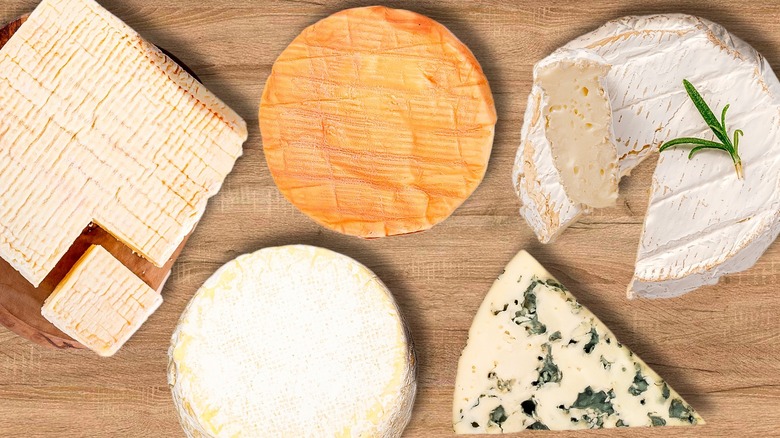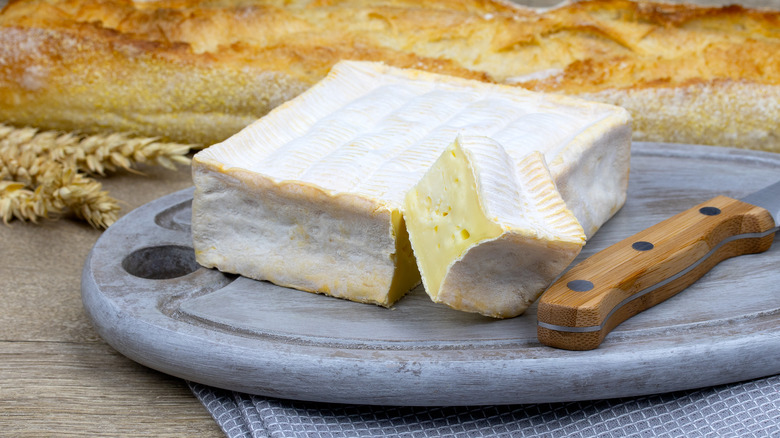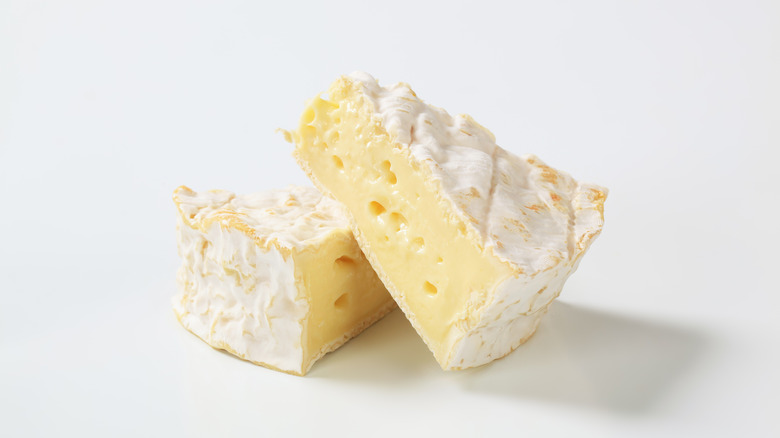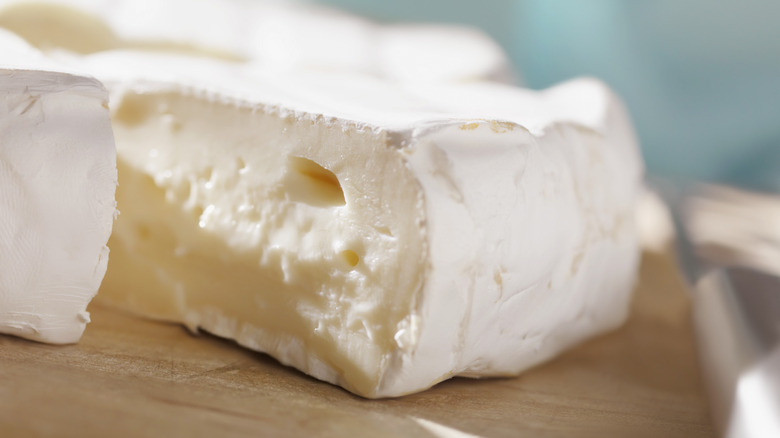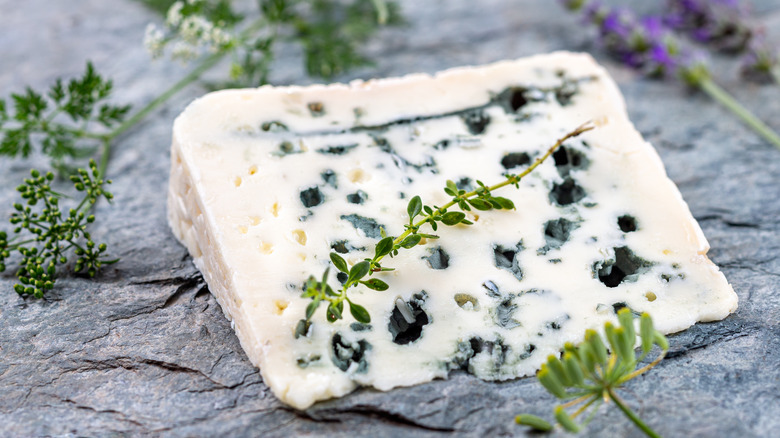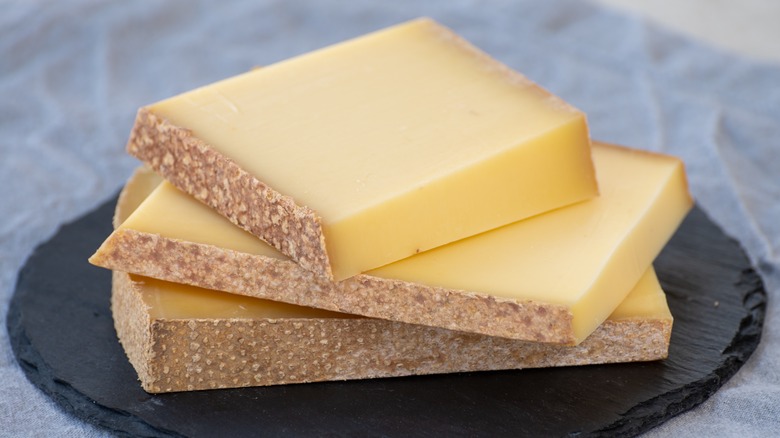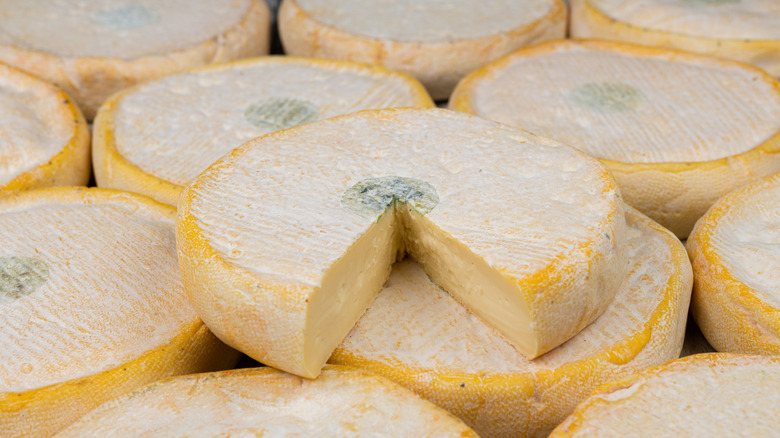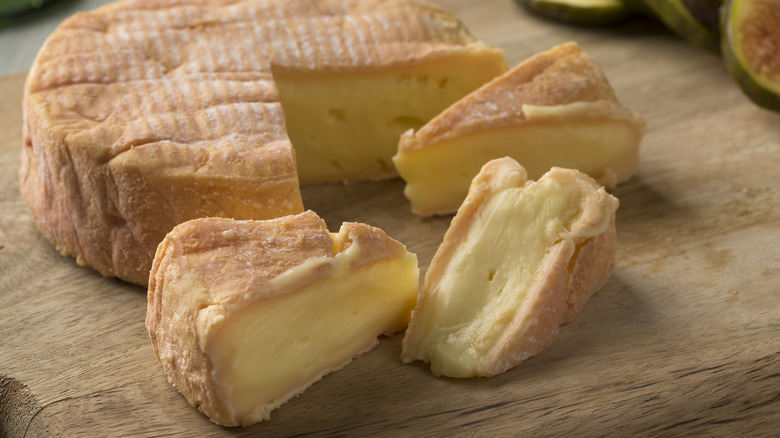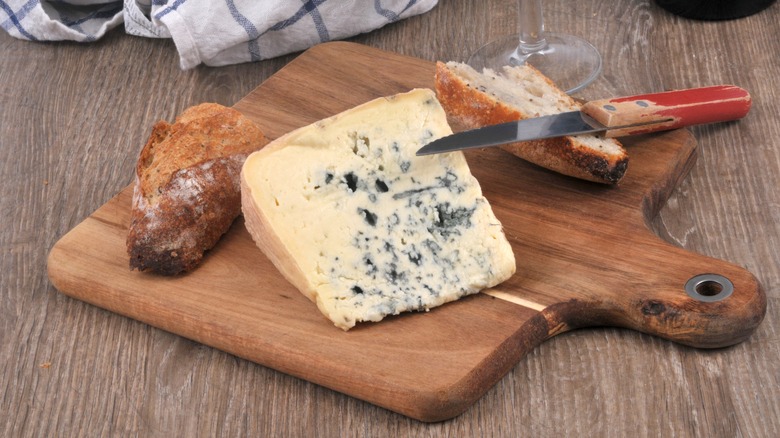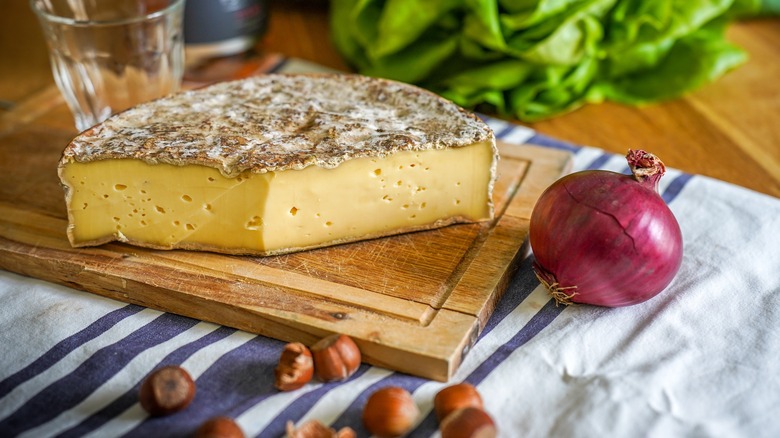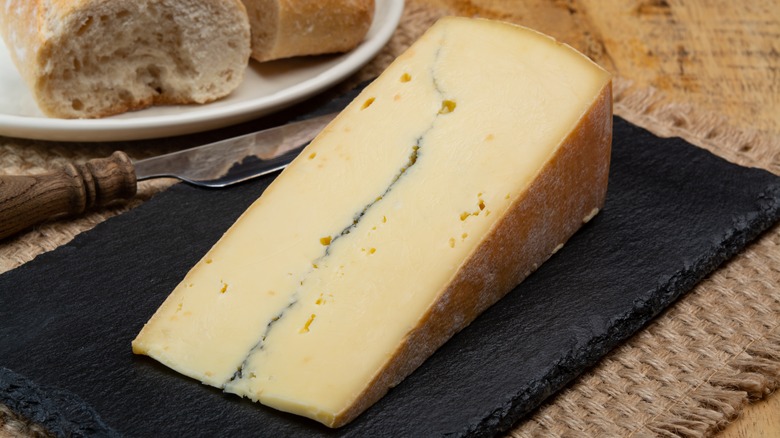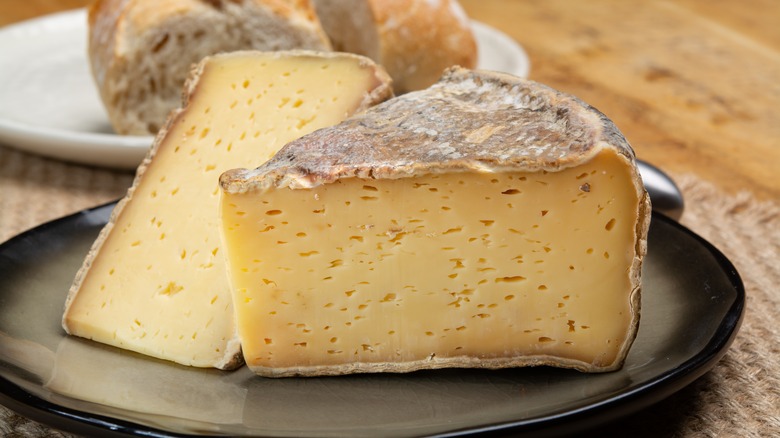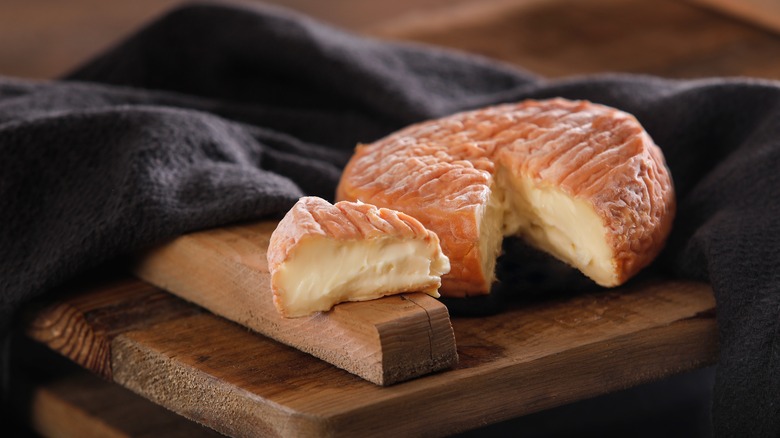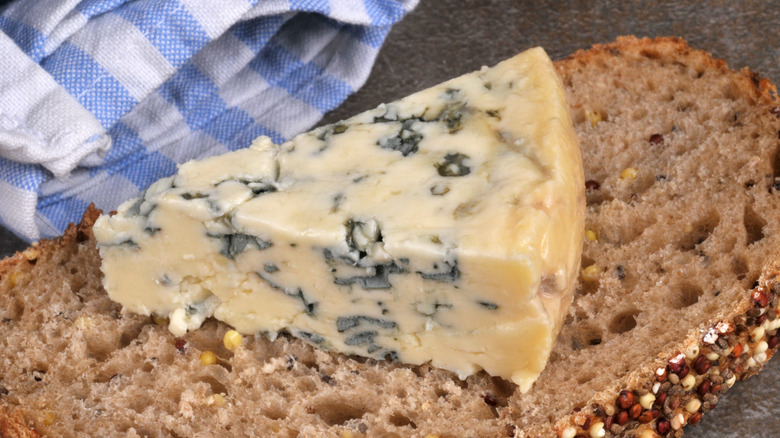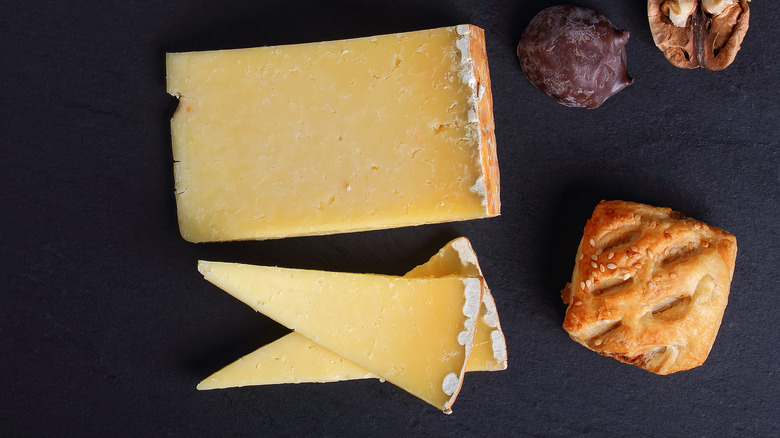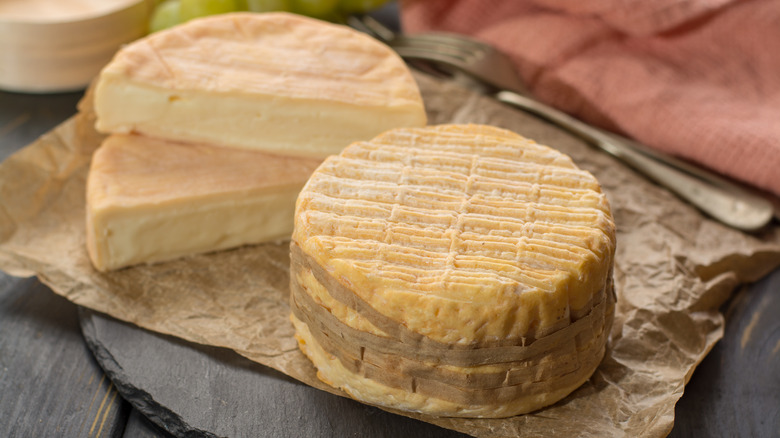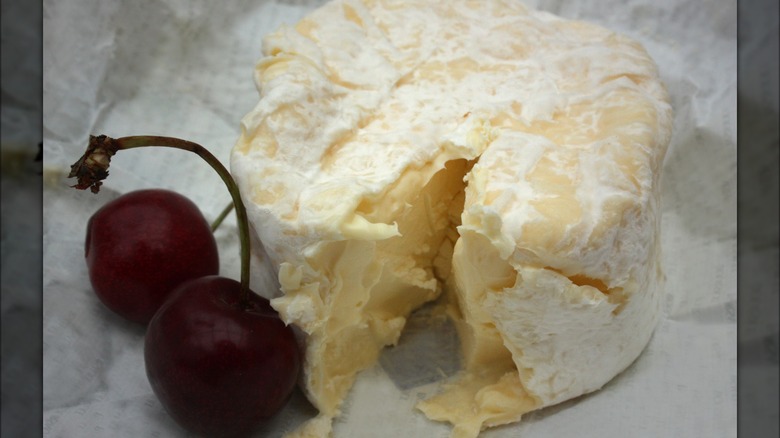16 French Cheeses You Need To Try At Least Once
For a cheese lover, stumbling into a cheese shop in Paris is like striking smelly, velvety, savory gold. Cheese is not just a snack in France, it's an integral part of the French national identity with a history that stretches back thousands of years.
France has some of Europe's most stringent laws when it comes to food, which is great news for consumers who love high-quality cheese. Many cheeses in France are also protected by laws that outline strict geographic and procedural rules for cheese production. While this limits the number of producers of a given type of cheese, it ensures that the integrity of the cheese-making process is upheld.
Because of the laws that regulate the sale of unpasteurized dairy products in the United States, many of the cheeses on this list can only be experienced in their true glory on French soil. So pack your bags and keep reading to learn more about the French cheese you need to try at least once.
Pont l'Évêque
Like so many French cheeses, Pont l'Évêque is named after a place. The little town of Pont l'Évêque is in Normandy, a region in Northern France known for producing some of the country's finest soft cheeses. The first thing you notice about this buttery cheese is that, unlike many of its creamy cousins, it's formed as a square block instead of a round wheel.
The rules for making Pont l'Évêque are many. First of all, you can't make this cheese just anywhere. The milk used to make it has to be from the area directly around the cheese's namesake village, and it has to come from cows that graze at least six months of the year. These rigid standards result in a luscious cheese with a bloomy rind that has a sharp, funky taste with a hint of grassiness that gets more intense with the age of the cheese.
Camembert
While you can find Camembert in many American grocery stores, buyers should know that not all variations of this famous soft cheese are created equal. In France, to call a cheese Camembert de Normandie, it must be made from raw milk obtained from certain parts of the country's Normandy region. It's also traditionally made using raw milk, which is illegal to sell in the U.S.
American Camemberts are made using the same basic method as the original Camembert de Normandie, but there's no replacement for the original. When it's made with raw milk, the flavors are more intense and complex. French Camembert tastes deliciously creamy, with a savory, mushroomy tang that gets more intense as the cheese ages. The subtle saltiness pairs perfectly with a light drizzle of honey and a glass of champagne.
Brie
Few French cheeses have stood the test of time like Brie. This soft, creamy cheese with its signature buttery interior and bloomy rind has been around since at least the eighth century, when King Charlemagne of the Franks deemed it royally delicious. Although the original Brie de Meaux is produced in the town of Meaux in France's Brie region, variations of Brie are wildly popular in France and around the world.
To serve and eat Brie like an expert, you've got to have an understanding of its flavor profile. While it famously gets more intense and funky as it ages, Brie is intensely smooth and rich with a hint of nuttiness. This makes it a perfect partner for the tang of a fruit jam or even the acidity of a cherry tomato. Brie sure to add this famous cheese to your next charcuterie board.
Roquefort
Walk into a cheese shop in Paris and you'll be hit in the face with a dank, musty aroma that makes some people hold their noses and others salivate. More likely than not, the most pronounced smell in the room will be coming from Roquefort, one of France's most famously stinky cheeses.
According to French law, to call a cheese Roquefort, it must be aged in the limestone caves that surround the town of the same name in Southern France. The history of this cheese stretches back hundreds of years. It's considered such an important national treasure that even France's King Charles VI helped protect Roquefort cheese in the 1400s. And if you have a bite, you'll see why. This raw sheep's milk cheese is strikingly complex with a crumbly, creamy texture and a distinctly sharp, almost metallic funk from the mold used to make it. Pair Roquefort with a dry red wine for a classy, unmatched flavor sensation.
Comté
A trip to the Jura mountains in Eastern France will be full of sweeping views, verdant farmland, and Comté cheese. Made with the raw milk of two types of cows (Montbeliarde and French Simmental), this cheese is nutty, grassy, and salty, although its flavor profile can vary drastically depending on a number of factors. Some cheese aficionados can even tell the difference between Comté made with winter and summer milk.
What makes Comté cheese unique is the specific technique used to make it. French law stipulates that any cheese calling itself Comté must be made from cows that each have at least a hectare (2.5 acres) of pasture for grazing, that the milk travels no more than 15 miles, and that the cheese is made within 24 hours of the cows being milked. With all of these regulations, it's no surprise that this cheese is a prized part of French culture. While Comté that's been aged for a long time has crunchy salt crystals and a hard texture, the younger variety is smooth and supple and great to add to a pot of fondue.
Reblochon
If happy cows make better cheese, then it's no wonder reblochon is so delicious. The cows used to make this soft cheese are allowed to graze at least 150 days of the year in the pastures of the picturesque Haute Savoie mountains where reblochon is made. Typically enjoyed during the winter months, this cheese has a washed rind, meaning that the cheese is washed in a brine that encourages the growth of certain types of bacteria that change the cheese's flavor and texture.
Even before you taste it, cutting into a wheel of reblochon is a sensory experience. The soft rind gives way to the knife to reveal a buttery, pale yellow interior that's buttery and soft and emits a warm, funky aroma. Pair it with a dry, mineral white wine to counter the intense creamy taste of the cheese. Unfortunately for those in America, if you want to try this majestically delicious cheese, you've got to book a flight to France because U.S. government regulations that govern the sale of dairy products mean that this cheese is unavailable stateside.
Munster
If you're into deli sandwiches, you might think you've had Munster on your turkey and cheese. But you'd be one letter off. While muenster cheese is a Wisconsin specialty widely available in deli slices, Munster, its European relative, was invented in the seventh century by monks in Eastern France. As you can see, Munster and muenster cheese have more differences than just spelling.
The French version is unpasteurized, so you can't find it in the States. Munster can be so soft that it practically oozes when cut and it's often spiced with cumin seeds to enhance its naturally intense, earthy flavor. Typically associated with the summer months, making Munster is a tricky process that requires the cheese to be rubbed with brine by hand until it develops its signature pink-orange rind. Only about 40 farmers in the Alsace region of France have the privilege of making cheese that they can legally call Munster.
Bleu d'Auvergne
Moldy isn't generally a term to describe something delicious, but in the case of blue cheeses, we make an exception. Bleu d'Auvergne, a soft, creamy cheese with a strong moldy flavor, is a great example of how mold can be a food's best friend. Cut into a wheel of Bleu d'Auvergne and the first thing you'll notice is irregular little holes lined with a dark blue coating of fungus, which is what gives this cheese its distinctly funky flavor.
Bleu d'Auvergne starts with the raw milk of cows that graze the pastures of Auvergne, the mountainous French region where this cheese is made. Compared with Roquefort, a sharp, moldy blue made with raw sheep's milk, this cheese is smoother and creamier and doesn't hit the nose with quite the same vigor. If you're just getting into blue cheese, this is a great gateway showcasing the magnificent flavor possibilities without the intense metallic spiciness of some stronger blues.
Saint-Nectaire
The history of Saint-Nectaire cheese starts in the mountains of Auvergne in Central France, where soil ripe with the ash of the region's dormant volcanoes created lush meadows and pastures. Produced and consumed regionally for centuries, Saint-Nectaire got its big break after it was introduced to King Louis XIV in the 1600s. And he had good taste: This creamy cheese showcases a delicate, rich flavor profile with notes of hazelnut and a softly acidic finish.
During the first couple weeks of maturation, the cheese is washed in a brine, which creates its signature bitter, gray bloomy rind. The wheels of Saint-Nectaire are aged for a minimum of four weeks, which allows them to develop their complex taste and rich texture. In fact, this cheese is so delicious that in 2018, roughly $12,000 worth of Saint-Nectaire was stolen from a cellar where it was aging. We can only hope that the thieves were wise enough to pair their loot with a medium-body red wine.
Morbier
While many French cheeses built their reputations on sharp, intense flavors, Morbier is famous for being pleasantly mild and easy on the senses. Visually, you can pinpoint Morbier in a cheese shop because of a distinctive gray band of vegetable ash that runs through the center of the cheese. It might seem strange for cheese to contain ash, but ash-ripened cheese is more than meets the eye.
Morbier was first developed in the mountains of Eastern France near the Swiss border, where cheesemakers took leftover curd from making another famous French cheese, Comté, and put it in a separate mold. The first layer of curd was covered in vegetable ash, which repelled harmful microbes and insects and kept the cheese from drying out so that another layer of curd could be added the next day. And voilà, Morbier was born. This semi-soft cheese is nutty, fruity, and pleasantly mild, with a springy, supple texture that melts beautifully.
Tomme de Savoie
Springtime in the mountains of France's Savoy region is all about the bright green of new grass, the chirping of birds, and a decent portion of tomme de Savoie cheese. The fact that the Savoyard dialect has a single word, "toma," to mean "a cheese made in the mountains," speaks to just how important cheese is to this Alpine region in Eastern France. This cheese has been around since at least the 1500s when farmers used milk leftover from making cream and butter in the winter to create these small rounds of cheese that could be enjoyed until the spring.
Because it's typically made with milk that's been skimmed, tomme de Savoie has a relatively low-fat content, with a semi-soft texture and a tangy, savory flavor with a discernible hint of grassiness. The cheese is made with raw cow's milk, which gives it an unmistakable complexity that pairs well with wines like Chardonnay and pinot noir.
Époisses
While organized religion can be a touchy subject, we can all get behind one of its famous French byproducts: cheese. Époisses was created by a community of Cistercian monks in the hilly French region of Burgundy over 600 years ago. And if you have one bite of Époisses, you'll see why this cheese stuck around for so long.
Époisses is for those who like their cheese soft and stinky. This cheese is so soft that in restaurants, it's often served with a spoon instead of a fork and knife so that you can comfortably scoop it instead of making a mess trying to slice it. During the ripening process, rounds of Époisses are periodically washed in marc de Bourgogne, a type of brandy, which gives the cheese a distinctive orange rind. Époisses is easily identifiable in a cheese shop because it's sold in a wooden box to keep its shape. And if you are eating this cheese at home, even your neighbors will know. Its pungent smell wafts far and wide, a preview to the grassy, earthy taste of the cheese that's carried by its thick, creamy texture. Some say that this cheese is so stinky that it's banned on the Paris Metro!
Fourme d'Ambert
Blue cheese can be a divisive subject. While some people love the moldy stink of funky blue cheese, others can't stand it. For people who are open to being converted to the smelly goodness of such cheese, fourme d'Ambert is a perfect first step.
Unlike some other intense blues, fourme d'Ambert has a mild moldy flavor embedded in a cheese that is beautifully balanced and smooth. This velvety, spreadable blue is so beloved in its native Auvergne region that there's a chapel in the town of Chaulme with a sculpted wheel of fourme d'Ambert looming over its entry. The history of this delicious dairy product reaches all the way back to Roman times, making it one of the oldest French cheeses you can buy. If you're looking for fourme d'Ambert in a cheese shop, you can recognize it because wheels of this cheese are unusually tall. But buyer beware: Because of its lasting popularity, many mass-produced, lower-quality versions of this cheese are available on the market.
Cantal
I wouldn't mind being a cow in Cantal, the hilly region of Southern France where this tangy, nutty cheese is produced. Cows that produce milk for Cantal cheese graze in volcanic mountains that sustain diverse pastures full of grass and wildflowers. And it's not for nothing. This strikingly complex hard cheese has a depth of flavor that reflects the lush environment where it's made.
Cantal has been around for at least 2,000 years, and it was enjoyed by the Romans who inhabited the region that is now France. It's enjoyed this impressive tenure because this cheese is flat-out delicious. Salty, grassy, moist, and dense, Cantal grows more piquant and complex as it ages. It's also thought to be the precursor to cheddar, a salty cheese popular here in the United States. Wheels of Cantal clock in at a massive 110 pounds, and if you're looking to enjoy a glass of wine with your cheese (and you should) the intense savory taste is best paired with a bold red like a cabernet sauvignon.
Livarot
Just a few hours away from Paris by train, France's Normandy region is a great weekend getaway, especially if you're into soft cheese. The small town of Livarot produces one of the region's most prized milky gems. Livarot cheese, named after the town itself, is soft and pungent, with an orange rind that is washed in brine during the aging process to give it a distinctively piquant aroma.
Because this cheese is so soft and creamy, fibers from sedge leaves are tied around the circumference of the cheese wheel so that it doesn't lose its shape. Livarot gained the nickname "the colonel" because the stripes formed by the leaves look like the stripes on a colonel's shoulder. Once the most popular cheese in Normandy, Livarot cheese was once the economic engine of its namesake town.
Boursault
Invented in the Val-de-Marne region just outside Paris in 1951, Boursault is one of France's younger cheeses. But what it lacks in age, it makes up for in creamy richness. Boursault is a soft-ripened cheese, meaning it's allowed to ripen just long enough to give the cheese shape and form without being washed in a brine. This results in a thin, edible rind with a mild flavor. It's also a triple cream cheese, indicating a milk fat content of at least 75%, which gives Boursault its characteristic buttery texture. Triple cream cheese is also known as the best type of cheese to pair with coffee, so if you're looking to add some cheesy intensity to your morning routine, pick up a round of Boursault.
Aged for a relatively short 12 days before it spends another month in its packaging, Boursault has a mild, buttery, fresh taste that goes well with light fruits like pears and grapes. The intense fattiness of this cheese is well-matched with Champagne or sparkling wine. If you like Brie and Camembert, you'll likely enjoy Boursault, which is just as luscious but has a milder flavor profile.
